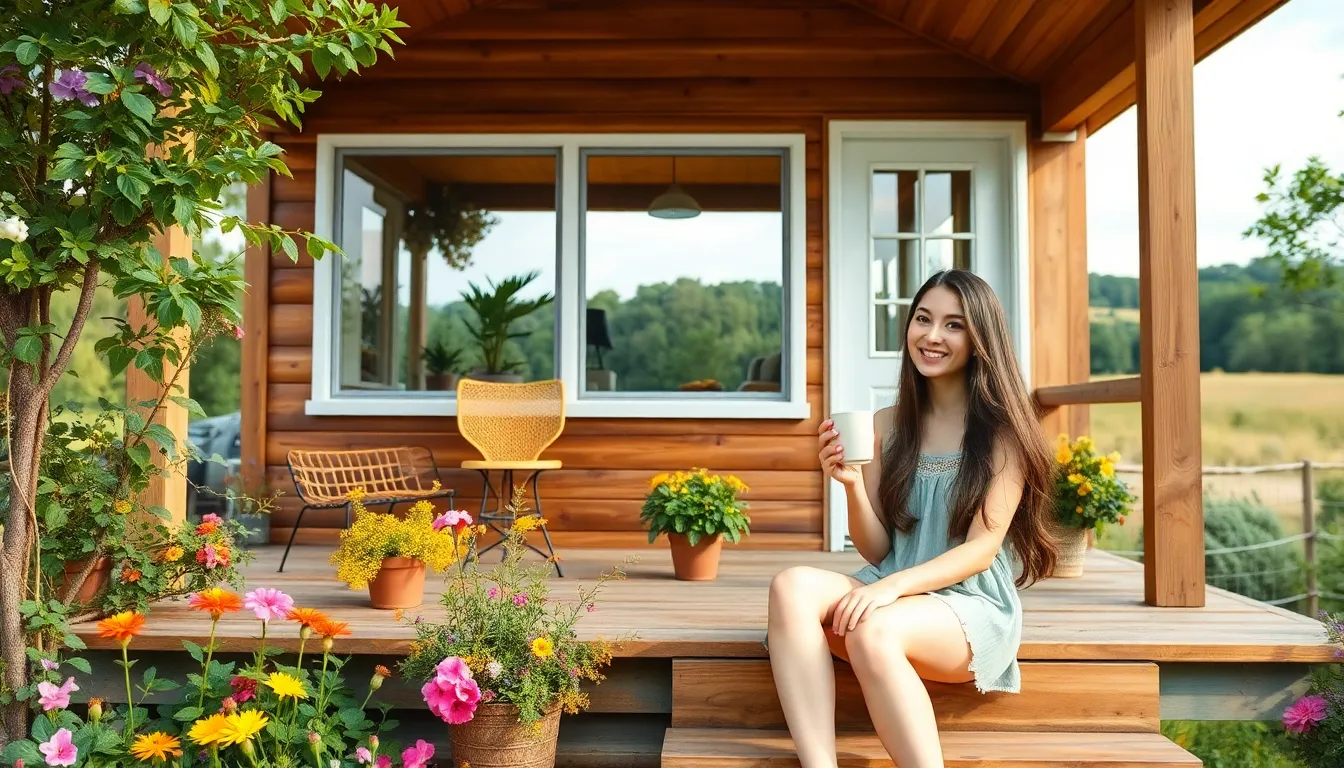Table of Contents
ToggleIn a world where bigger often seems better, tiny homes are flipping the script. These pint-sized powerhouses are revolutionizing the way people think about living space, proving that less really can be more. Imagine cozy nooks, multifunctional furniture, and a lifestyle that prioritizes experiences over excess. Who knew that downsizing could lead to upsized happiness?
Overview Of Tiny Home Design
Tiny home design represents a shift toward minimalist living. This design philosophy emphasizes efficiency and simplicity while maximizing every square foot. Functionality remains central to the design, ensuring that each area serves multiple purposes.
Compact floor plans characterize tiny homes, allowing for innovative use of space. Living areas often blend seamlessly with kitchen spaces, creating an open, airy feel. Storage solutions integrate into walls and furniture, reducing clutter while maintaining usability.
A focus on sustainability permeates tiny home design. Many builders use eco-friendly materials and energy-efficient appliances. Solar panels and rainwater harvesting systems often feature in new models, enhancing self-sufficiency.
Natural light plays a crucial role in these homes. Large windows and skylights brighten interiors, making spaces appear larger. Thoughtful placement of openings encourages cross-ventilation, improving air quality.
Design influences vary widely, from modern aesthetics to rustic charm. Some occupants favor industrial looks with exposed beams, while others prefer cozy, cottage-inspired styles. Adaptable designs cater to various lifestyles, with some focusing on mobility.
Communities dedicated to tiny living are emerging across the country. These neighborhoods foster a sense of belonging among residents while promoting sustainable living practices. Shared amenities often enhance social interactions and reduce individual resource consumption.
Ultimately, tiny home design balances minimalism with functionality. The approach encourages occupants to prioritize experiences over possessions, aligning lifestyle choices with values of sustainability and community. Embracing tiny homes can lead to more fulfilling living environments and a deeper connection with one’s surroundings.
Key Features Of Tiny Homes
Tiny homes incorporate essential features designed to maximize space and promote sustainable living. Each element plays a role in enhancing comfort and functionality.
Space Optimization Techniques
Space optimization techniques thrive in tiny home designs. Multi-functional furniture serves dual purposes, such as a bed that converts into a sofa. Vertical storage solutions utilize wall space, allowing for storage without occupying floor area. Built-in shelving integrates storage seamlessly into the design, keeping items organized and accessible. Open floor plans create an illusion of spaciousness, allowing residents to move freely. Custom cabinetry takes advantage of nooks and corners, ensuring that every inch of space is productive. Creativity in layout results in room arrangements that enhance livability while maintaining aesthetic appeal.
Sustainable Materials
Sustainable materials form the backbone of many tiny homes. Bamboo flooring provides durability while minimizing environmental impact. Reclaimed wood adds character, and its use supports recycling efforts. Natural stone incorporates aesthetics and resilience, perfect for countertops or exterior details. Eco-friendly insulation options, such as cellulose or sheep wool, improve energy efficiency and reduce carbon footprint. Additionally, energy-efficient appliances contribute to lower utility bills and support a sustainable lifestyle. Solar panels harness renewable energy, allowing homeowners to reduce reliance on non-renewable resources, underscoring a commitment to environmental stewardship in tiny home living.
Popular Tiny Home Designs
Tiny homes come in various styles, catering to diverse preferences and lifestyles. Two popular designs include modern tiny homes and rustic tiny cabins, each offering unique features and advantages.
Modern Tiny Homes
Sleek lines and minimalist aesthetics define modern tiny homes. Emphasis on open floor plans enhances the feeling of spaciousness while incorporating large windows invites natural light. Smart home technology often integrates into these designs, allowing for energy efficiency and convenience. Modular components streamline construction and ensure flexibility in design. Many modern tiny homes use eco-friendly materials such as recycled steel and sustainable wood, reinforcing commitment to sustainability. Contemporary colors and finishes foster a fresh, inviting atmosphere, making these homes appealing to young professionals and families alike.
Rustic Tiny Cabins
Charming and cozy, rustic tiny cabins bring a sense of warmth and nostalgia. Natural materials like log siding and reclaimed wood create a connection to nature, emphasizing sustainability. Often located in scenic settings, these cabins provide a retreat from urban life. Large porches and covered decks enhance outdoor living, fostering relaxation and a connection to the surrounding environment. Interior designs prioritize comfort with features like wood-burning stoves and traditional furnishings that evoke a cabin feel. Rustic tiny cabins often double as vacation homes, making them popular among those seeking a peaceful getaway.
Benefits Of Tiny Home Living
Tiny home living offers a variety of advantages that cater to an evolving lifestyle. These benefits support minimalist choices and prioritize sustainability while enhancing overall well-being.
Affordability
Affordability stands as a primary attraction for those considering tiny homes. Lower construction costs typically translate to reduced monthly mortgage payments, fostering financial freedom. Homeowners save on property taxes due to decreased home valuations. Maintenance expenses also diminish, as smaller spaces require fewer resources for upkeep. The ability to allocate funds toward travel or experiences encourages a lifestyle shift away from material accumulation. Ultimately, owning a tiny home enables individuals to embrace a sustainable living practice while enjoying financial ease.
Eco-Friendliness
Eco-friendliness significantly influences the appeal of tiny houses. Smaller footprints reduce energy consumption, allowing occupants to live with less impact on the environment. Many tiny homes utilize sustainable materials such as reclaimed wood or bamboo, promoting responsible resource use. Solar panels and energy-efficient appliances further enhance their green credentials. Water conservation systems, like rainwater harvesting, contribute to a more sustainable lifestyle as well. By prioritizing eco-friendly design, tiny home dwellers align their living choices with a commitment to preserving the planet for future generations.
Challenges In Tiny Home Design
Tiny home design presents unique challenges that demand careful consideration. Space constraints and zoning regulations play significant roles in the planning and execution of tiny homes.
Space Constraints
Space constraints define the essence of tiny home living. Limited square footage requires innovative layouts and multifunctional furniture solutions. Occupants often face difficulties organizing their belongings efficiently. As a result, clever storage options such as built-in shelves, under-bed storage, and multipurpose furniture become essential. Maximizing vertical space helps create an illusion of openness, but it also presents challenges in terms of accessibility. Residents may find it demanding to maintain a clutter-free environment while incorporating personal touches. Designing for both comfort and functionality within tight confines remains a critical focus for tiny home enthusiasts.
Zoning Regulations
Zoning regulations impose restrictions that can complicate tiny home placement. Many areas enforce minimum square footage requirements for residential structures, often excluding tiny homes from residential zones. Compliance with local building codes frequently necessitates creative solutions, including special permits or variances. Safety standards also play a significant role, ensuring that tiny homes adhere to necessary requirements for plumbing and electrical systems. Communities often lack established frameworks for tiny home living, leading to uncertainty for prospective homeowners. Understanding local regulations and advocating for changes can facilitate the acceptance of tiny homes in various neighborhoods.
Tiny home design represents a transformative approach to living that prioritizes simplicity and sustainability. By embracing smaller spaces individuals can foster a deeper connection with their surroundings while reducing their environmental impact. The innovative use of multifunctional furniture and efficient layouts not only maximizes space but also enhances the overall quality of life.
As more people seek to align their living choices with their values tiny homes offer a viable solution that promotes both community and eco-friendliness. The appeal of tiny living extends beyond mere aesthetics; it’s about creating fulfilling experiences and nurturing a lifestyle that values connection over consumption. With the right design elements and a commitment to sustainable practices tiny homes can truly redefine what it means to live well.



